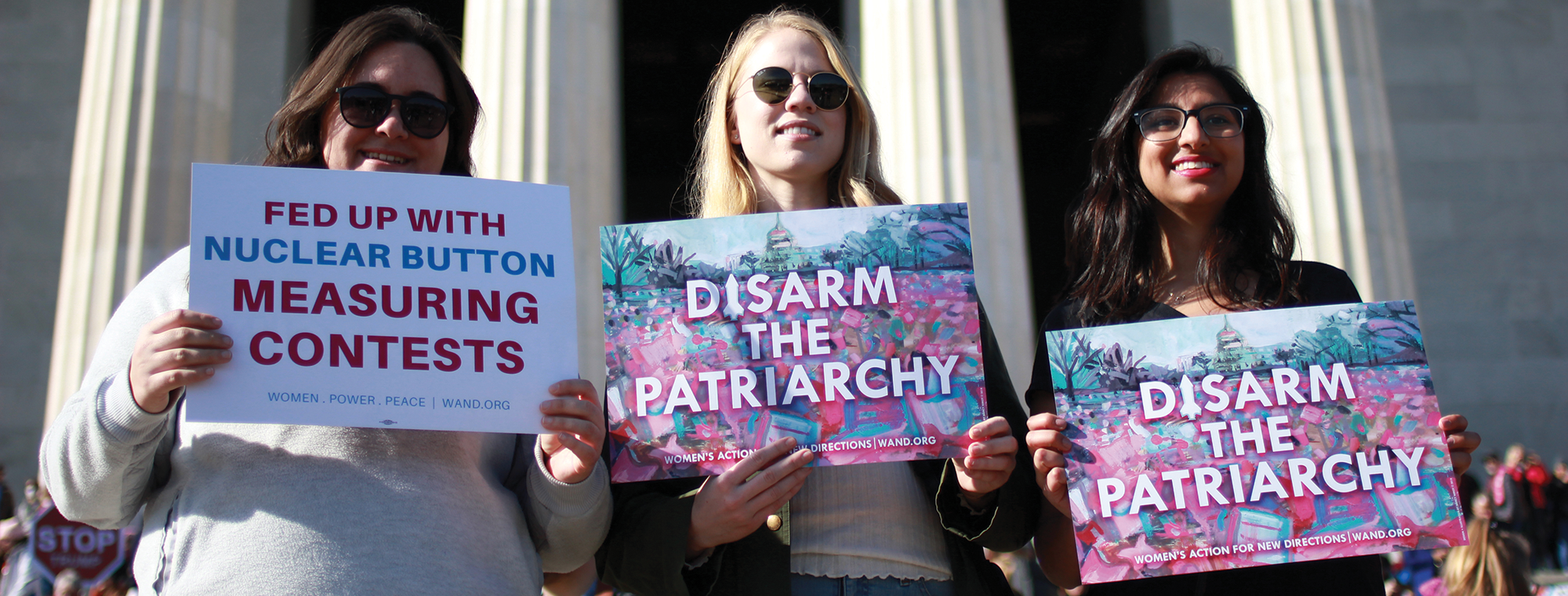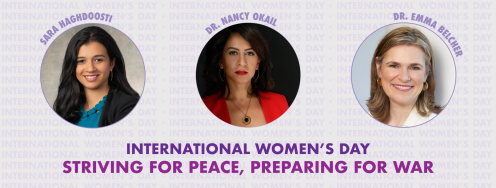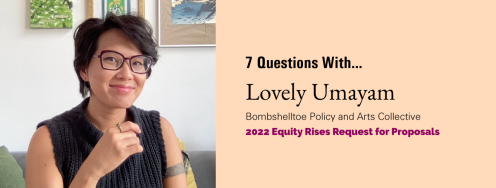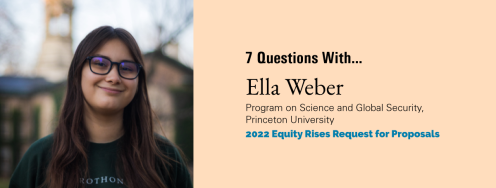By Dr. Kennette Benedict
The legitimacy of American democracy is rooted in political participation. Since the end of World War II, however, participation in national security policymaking by citizens, and even by most elected representatives, is no longer considered legitimate. This is especially true for decisions about nuclear weapons. Despite the Constitution’s provision that only Congress has the right to declare war, it is the president who has the sole authority to launch nuclear weapons and begin nuclear war, with the capability to ignite destruction beyond imagination. Since 1945, when the atomic bomb was first used, the rights of citizens and their representatives to shape national security policy, to participate in debate and even to access information about government military plans have been greatly diminished.
How can citizens restore their right to represent their own interests on issues of war and peace? How can authoritarian nuclear policy be challenged? What would democratic processes of national security policymaking look like?
These limits to citizen rights began in the aftermath of World War II and the onset of the Cold War. Political and military leaders argued that secrecy was required as the US government fought an ideological war and engaged in a nuclear arms race with the Soviet Union. Fear of Stalin’s Russia, and especially fear of the Soviet bomb drove ever stricter constraints on who could have access to information and who could participate in national security policy. Nuclear secrecy hampers the ability of citizens to hold government accountable for weapons programs, and, in turn, reduces robust congressional oversight.1
The result is that presidents and military leaders, along with their expert advisers, have enlarged their political power and rendered citizen participation illegitimate. The most obvious result was the alarming growth of US nuclear weapons in the 1950s and 1960s and continued stockpiles through the 1980s.2
Citizens have not acquiesced completely in the face of a growing national security state. They have taken direct action at critical junctures over the past 70 years, pressuring Congress and the White House, to freeze and reduce the number of nuclear weapons. Their success is worth recounting to demonstrate how citizen action and expression of their preferences can change nuclear weapons policy today.
In the 1950s, doctors found strontium-90 from radioactive fallout in babies’ teeth and in mothers’ breast milk.3 Citizens, including many women who were outraged that weapons testing programs could harm them directly, organized protests. Women Strike for Peace, a network of some 50,000 women organized in 1961 to protest nuclear testing, was one of the most dynamic new forces in a larger disarmament movement.4 These newcomers, along with college students who joined the venerable National Committee for a Sane Nuclear Policy (SANE), provided new energy and a public presence that resulted in the 1963 Limited Test Ban Treaty.
In the 1980s, the US nuclear freeze movement and the European Committee on Nuclear Disarmament protested the Reagan administration’s buildup of nuclear weapons.5 With public outreach and education, SANE membership grew by 800 percent, and a revived Physicians for Social Responsibility and the new Women’s Action for Nuclear Disarmament (WAND) pressed for a stop to the arms buildup.6 These and other groups pushed for both the United States and the Soviet Union to ban testing, production and deployment of nuclear weapons. A June 1982 demonstration in New York City drew almost 1 million people, and surveys found that 71 percent of Americans favored the Nuclear Freeze.7 In May 1983 the House of Representatives responded by passing a Freeze resolution by a vote of 278 to 149.8 Citizen protests and mobilization, popular books like Jonathan Schell’s “Fate of the Earth” and films like “The Day After” (which President Reagan viewed on television) contributed to an urgent need to control nuclear weapons, and ultimately end the Cold War.
Beginning in 2007, another civic group of nongovernmental organizations, the International Campaign to Abolish Nuclear Weapons (ICAN), organized non-nuclear weapons states under the auspices of the United Nations (UN) to call for the abolition of nuclear weapons. At conferences of the leaders of these countries, international relief agencies, scientists and physicians’ groups illustrated the consequences of a future nuclear war for all countries, not just for the nuclear weapons states. The negative effects on the climate, the disruption of aid to developing countries as international organizations dealt with the aftermath of nuclear war, and the devastation to a fragile global economy would have profound effects on all countries of the world, not just on nuclear weapons states. Informing leaders of emerging economies and developing countries of the destruction from nuclear weapons led 122 countries to adopt a new UN treaty in 2017 that would ban nuclear weapons, becoming the Treaty on the Prohibition of Nuclear Weapons.9
Today, nuclear weapons states are calling again for the buildup and modernization of their nuclear arsenals. While efforts to reason with policymakers about the dangers and costs of this new nuclear arms race are worthwhile, lessons from past nuclear disarmament movements suggest that a much wider campaign is needed to exert pressure. This campaign would call on citizens to learn about nuclear weapons, to question their governments and to reveal nuclear secrecy for what it is — an instrument for the few to reduce citizens to wards of the state while allowing presidents and guardians of these arsenals to maintain ultimate power over life on Earth.
To build a more democratic process for nuclear policymaking, one that places citizens at the center of nuclear weapons governance, requires new habits of thought and a new process of nuclear policymaking based on democratic participation. Such a process will include several elements.
First, the people’s representatives in Congress will need to reclaim their right to decide issues of war and peace, foremost among these: how and whether nuclear weapons should be used. Presidential sole authority to launch nuclear weapons has long been questioned as unconstitutional by legal scholars.10 Senator Ed Markey and Representative Ted Lieu introduced legislation in 2017 that would prohibit the president from launching nuclear weapons, unless in retaliation for a nuclear attack, without permission of Congress.11 Representatives Markey, Lieu and their 93 co-sponsors argue that the use of nuclear weapons, when not in retaliation against an enemy strike, constitutes a declaration of war.
A similar measure introduced by Representative Adam Smith (D- WA) and Senator Elizabeth Warren (D-MA) in 2019 proposes that the United States refrain from the first use of nuclear weapons, effectively preventing the president from launching nuclear weapons unless in retaliation.12 Article II of the US Constitution empowers the Congress — not the president — to declare war, but under current practice, the president can initiate war by launching nuclear weapons without even consulting Congress. Clearly, this arrangement defies the founders’ intent to prevent a concentration of power in the hands of one person, a situation they feared would turn the president into a king.
Second, to make informed decisions, citizens require authoritative public information about nuclear weapons and military plans. National secrecy about nuclear weapons makes it very difficult for people and the people’s representatives to understand what is being contemplated, how much it will cost and what the implications and consequences are of using nuclear weapons. Such secrecy flies in the face of the most rudimentary needs for accountability in a democracy. The government must publish more information about nuclear arsenals, their numbers, launch readiness and details of the nuclear posture including plans for war.
Despite state secrecy, independent analysts and journalists have provided information that helps hold decisionmakers to account. Among these is the Nuclear Notebook, published since 1987 by the Bulletin of the Atomic Scientists, providing estimates of states’ nuclear weapons arsenals along with analysis of force structures and capabilities.13 The Bulletin’s Doomsday Clock, backed initially by those who worked on the first atomic bomb, has informed the public about the risks of nuclear weapons since 1947.14 These efforts raise awareness and provide assessments of the enormity of the problem.
Third, the public needs to hear from independent experts who challenge bureaucratic complacency. Those former government officials who step out of the circle of secrecy to alert citizens about the dangers of nuclear weapons perform a necessary public service and deserve continuing support from academic institutions, media organizations and civic groups. For example, in their recent memoirs former US Defense Secretary William Perry and former US Defense Department analyst Daniel Ellsberg provide valuable information from an insider’s point of view that pierces the veil of government secrecy used to keep citizens at a distance from the policymaking process.
Fourth, nuclear weapons issues need to be discussed in every election cycle and at every government level — city, state and federal. Just as health care, education, tax and economic policies are part of every election debate, nuclear weapons and military plans should be raised at election time. Even more important, the prospective uses and likely effects of these weapons, with their potential for genocide, need addressing at every turn. Whether the focus is on how the nation’s international policy goals will be furthered or damaged by threatening the use of nuclear weapons, or how nuclear exchanges will affect us in cities and regions across the country, the use of nuclear weapons will wreak such havoc that citizens need to know what the likely consequences are and whether they wish to unleash this destructive technology. Political leaders will need to have answers and will need to acquire much more knowledge than they currently have to answer constituents’ questions. Only then will citizen judgments about nuclear policy be reflected at the ballot box.
Fifth, knowledge about nuclear weapons and government policy needs to be taught in educational institutions and through cultural programs. Social protest is useful in raising awareness and constraining political leaders in the short-term, but to achieve lasting results and develop new habits of thought requires ongoing programs of education in schools, colleges and universities. New lesson plans and courses on nuclear weapons policy could be developed and required, just as math and language courses are. Nuclear literacy should be reinforced in museum exhibitions, art festivals and social media in ways that stimulate further curiosity about the consequences of possessing and using nuclear weapons.
Sixth, US citizens can reach across political borders to ally with counterparts in other countries, and especially with those in nuclear weapons states. The focus of this communication would be to learn about practices in those countries and identify shared interests in prohibiting nuclear weapons and ensuring our common survival and prosperity.
These recommendations are based on expert analysis and data, and also upon my own experiences. I came up in the women’s movement, which practiced participatory democracy. After graduate school, where I studied American politics and democratic theory, and my first encounters with the bomb and international security, I found myself coming up against a problem: I would ask a question about nuclear weapons and experts with security clearances would say “if only you knew, you would understand, but I can’t tell you.” I realized then that there was a huge democratic deficit when it came to nuclear weapons policy. Yet I understood that the legitimacy of American democracy rests on knowledge and participation.
To restore our representative democracy, public discussion of all aspects of nuclear weapons is urgently needed. For too long, a very small group of experts and political and military leaders have decided the fate of the country, and, indeed, the fate of the world. My experience in the women’s movement was life altering because it empowered us to challenge conventional wisdom and to demand a seat at the policymaking table. That’s what feminist and other diverse perspectives can bring to this issue.
Broadening participation in nuclear weapons policymaking will require government to reduce secrecy, public officials to take responsibility for decisions about war and peace, educators and cultural workers to make knowledge about nuclear weapons accessible to citizens, and citizens to demand that their representatives serve their legitimate interests in securing a future free of catastrophic destruction from nuclear weapons.
Dr. Kennette Benedict is senior adviser to the Bulletin of the Atomic Scientists and lecturer at the University of Chicago Harris School of Public Policy. Previously, she was the executive director and publisher at the Bulletin from 2005 to 2015, and before that was the director of international peace and security at the John D. and Catherine T. MacArthur Foundation from 1991 to 2005. She currently serves on the Advisory Council of the Stanley Foundation and is a member of the Chicago Council on Global Affairs, as well as the Council on Foreign Relations and the International Institute of Strategic Studies. She is a member of Ploughshares Fund’s board of directors.
This article is part of our new report, "A New Vision: Gender. Justice. National Security." See all the articles from our report here.
Political participation is essential to a representative #democracy and our #NewVision2019.
Notes
1 Stephen I. Schwartz, et al. Atomic Audit: The Costs and Consequences of US Nuclear Weapons Since 1940 (Washington, D.C.: Brookings Institution Press, 1998): 433-483.
2 “Nuclear Notebook: Nuclear Arsenals of the World,” Bulletin of the Atomic Scientists, accessed December 7, 2018, https://thebulletin.org/nuclear-notebook-multimedia/.
3 Walter Sullivan. “BABIES SURVEYED FOR STRONTIUM 90; Ratio to Calcium in Bones Is Discovered to Be Low A survey has shown that pregnant mothers and their unborn children absorb radioactive strontium, as a substitute for calcium, only about 10 per cent of the time,” New York Times, Nov. 25, 1961, https://www.nytimes.com/1961/11/25/archives/babies-surveyed-for-strontium-90-ratio-to-calcium-in-bones-is.html.
4 Amy Swerdlow, Women Strike for Peace: Traditional Motherhood and Radical Politics in the 1960s (Chicago, IL: The University of Chicago Press, 1993).
5 Lawrence S. Wittner. “The Nuclear Freeze and Its Impact,” Arms Control Today, (Arms Control Association, December 5, 2010), https://www.armscontrol.org/act/2010_12/LookingBack.
6 Lawrence S. Wittner. Confronting the Bomb: A Short History of the World Nuclear Disarmament Movement (Stanford, CA: Stanford University Press, 2009): 153.
7 Teresa Tritch. “From Nuclear Freeze to Global Warming — and Back” New York Times, Sept. 23, 2014, https://takingnote.blogs.nytimes.com/2014/09/23/from-nuclear-freeze-to-global-warming-and-back/.
8 Leilah Danielson, “The Peace Movement since 1945,” American History: Oxford Research Encyclopedias, May 2015, http://oxfordindex.oup.com/view/10.1093/acrefore/9780199329175.013.71.
9 “Treaty on the Prohibition of Nuclear Weapons, Status of the Treaty,” United Nations Office for Disarmament Affairs, accessed December 7, 2018, disarmament.un.org/treaties/t/tpnw. [Editor: replacement link: https://treaties.un.org/Pages/ViewDetails.aspx?src=TREATY&mtdsg_no=XXVI-9&chapter=26&clang=_en]
10 Arthur S. Miller and H. Bart Cox, “Congress, the Constitution and First Use of Nuclear Weapons,” The Review of Politics 48, no. 3 (Summer 1986): 424-455.
11 US Congress, House, Restricting First Use of Nuclear Weapons Act of 2017, H.R.669, 115th Congress, introduced in House January 24, 2017, https://www.congress.gov/bill/115th-congress/house-bill/669.
12 US Congress, House, To establish the policy of the United States regarding the no-first-use of nuclear weapons, H.R.921, 116th Congress, introduced in House January 30, 2019, https://www.congress.gov/bill/116th-congress/house-bill/921.
13 The Nuclear Notebook is written by experts at the Federation of American Scientists and published in the Bulletin of Atomic Scientists; “Nuclear Notebook: Nuclear Arsenals of the World,” Bulletin of the Atomic Scientists, accessed December 7, 2018, https://thebulletin.org/nuclear-notebook-multimedia/.
14 “Doomsday Clock,” Bulletin of the Atomic Scientists, accessed December 7, 2018, https://thebulletin.org/doomsday-clock/.
Photo: Women's Action for New Directions with 'Disarm the Patriarchy' signs at the 2018 Women's March, Washington, DC. Image: Corey Greer, WAND




